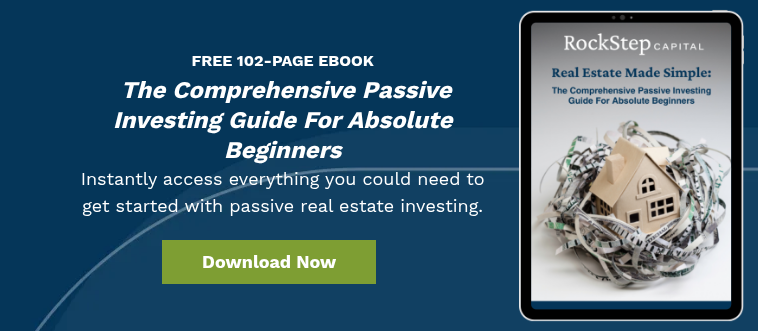Understanding Risk Profiles: What New Passive Real Estate Investors Need to Know
February 19th, 2025
5 min read

Real estate investing is one of the most powerful ways to build long-term wealth, but not all investments are created equal. Some are safe and steady, offering reliable income with minimal surprises. Others require strategic improvements, demanding more effort but delivering higher returns. And then there are the high-risk, high-reward ventures, where investors take on major redevelopment projects to unlock significant upside potential.
A risk profile in real estate investing refers to the level of risk associated with a particular property or investment strategy. It helps investors determine the potential return on investment (ROI), the amount of capital required, and the likelihood of achieving stable cash flow or property appreciation.
Each category presents a different balance of risk and reward, and choosing the right approach is like picking a travel method for a cross-country road trip. Do you prefer a first-class flight with minimal turbulence? A scenic road trip with a few detours for adventure? Or an off-road expedition into uncharted territory?
Let’s examine these risk profiles in detail to assist you in identifying which investment strategy aligns best with your financial objectives.
Core Investments: The First-Class Flight of Real Estate
A core investment refers to a stabilized, high-quality property in a prime location with minimal risk and steady, predictable cash flow. These properties are typically fully leased to strong, long-term tenants and require little to no improvements.
Core investments are typically located in high-demand areas, such as thriving metropolitan districts or affluent suburban shopping centers. Creditworthy tenants occupy these assets on long-term leases, which means investors enjoy steady cash flow without the headaches of major renovations or lease-up efforts.
Overall, core real estate investments are like first-class flights—smooth, predictable, and designed for comfort. These properties are already stabilized, meaning investors can expect consistent income with minimal risk.
Example of Core Investments in Real Estate
Imagine an investor buying a high-end shopping center in a thriving suburban neighborhood. This center features anchor tenants such as Target, Starbucks, and Whole Foods, all secured with long-term leases. The shopping center is already operating at nearly full capacity, and its tenants have consistently demonstrated strong sales and reliability.
Value-Add Investments: The Scenic Route to Higher Returns
A value-add investment involves acquiring a property that is underperforming in some way and improving it to increase cash flow and value. This could mean renovating outdated spaces, improving tenant mix, optimizing management, or filling vacancies.
These properties may suffer from:
- Vacancies that need to be filled.
- Inefficient management that drags down performance.
- Outdated features that deter tenants and customers.
Value-add real estate is like taking the scenic route on a road trip—you need to make some stops along the way, but the detours lead to rewarding discoveries. These properties have strong potential but require strategic improvements to maximize profitability.
Example of Value-Add Investments in Real Estate
A sponsor acquires a dated strip mall with 60% occupancy in a fast-growing suburban area. The storefronts are faded and outdated, the parking lot is cracked and uninviting, and the marketing efforts are practically non-existent.
The sponsor plans to revamp the center, modernize the facades, improve the tenant mix, and fill the vacancies. After two years, the center is now 90% leased and features trendy restaurants and high-traffic retailers. The outcome is higher rents, increased foot traffic, and a significant boost in property value.
Opportunistic/Distressed Investments: The Off-Road Adventure
An opportunistic investment is the highest-risk, highest-reward strategy in real estate. These properties often require major redevelopment, ground-up construction, or a complete repositioning to become profitable. At the time of acquisition, they typically have little to no income, and success depends on the sponsor’s ability to execute a complex business plan.
A distressed property is a specific type of opportunistic investment that is financially or physically struggling, often due to high vacancies, mismanagement, or market downturns. These properties may be acquired at a steep discount, but they require significant capital and operational improvements to restore profitability.
Opportunistic projects may involve:
- Redeveloping abandoned shopping centers into modern mixed-use spaces.
- Repurposing big-box stores into entertainment hubs or medical centers.
- Constructing entirely new developments from the ground up.
Opportunistic and distressed real estate is like venturing into uncharted territory in search of gold. These properties require substantial effort, capital, and expertise to become profitable.
These investments carry the highest level of risk, but if executed successfully, they can generate extraordinary returns.
Example of Opportunistic/Distressed Investments in Real Estate
A sponsor acquires a vacant big-box retail store in a struggling shopping district. Rather than leasing it to another retailer, they redevelop the site into a mixed-use community with apartments, restaurants, and office space.
This requires securing zoning approvals for new land use, investing millions in construction and redevelopment, and attracting new tenants and businesses to revitalize the area. After four years of development, the project is fully leased and becomes a thriving community hub, dramatically increasing its value.
Why This Matters For Investors
Understanding risk profiles is essential for passive investors because it helps align investments with financial goals and risk tolerance. Core investments offer steady, predictable income, making them ideal for those prioritizing capital preservation. Value-add properties balance risk and reward, requiring improvements but offering higher potential returns. Opportunistic investments carry the highest risk but can deliver exceptional profits if successfully executed.
Choosing the right sponsor is just as important as selecting the right investment type. A skilled sponsor can transform underperforming properties into high-value assets, while an inexperienced one can struggle—even with a promising deal. By understanding risk profiles, investors can make informed decisions, manage expectations, and build a diversified portfolio that suits their long-term strategy.
Building a Smarter Investment Strategy
Real estate investing offers a range of opportunities. Still, success depends on more than just picking a property—it requires a clear understanding of how risk and return align with your financial objectives. By recognizing the differences between core, value-add, and opportunistic investments, passive investors can make more strategic decisions about where to allocate their capital.
Beyond risk tolerance, it’s also important to consider factors like investment timeline, liquidity needs, and the level of involvement you're comfortable with. Core investments may be ideal for long-term stability, while value-add and opportunistic deals often require a willingness to wait for returns. Diversifying across different risk profiles can also be a smart way to balance income, appreciation, and overall portfolio resilience.
Next Steps In Your Investment Journey
Now that you understand the different risk profiles in passive real estate investing, the next step is to put that knowledge into action. Here’s how you can move forward with confidence:
- Assess Your Investment Goals: define what you’re looking for in an investment. Are you prioritizing stable cash flow, long-term appreciation, or high-reward opportunities? Understanding your goals will help you determine whether core, value-add, or opportunistic investments are the right fit.
- Evaluate Your Risk Tolerance: Consider how much risk you’re comfortable taking. Core investments might be ideal if you prefer low volatility and predictable income. If you’re open to more risk in exchange for higher potential returns, value-added or opportunistic deals could be worth exploring.
- Find the Right Sponsor: Not all real estate investment opportunities are equal. Research and collaborate with a sponsor with a proven track record, strong market expertise, and a clear investment strategy that aligns with your goals.
- Diversify Your Portfolio: Consider investing across risk profiles to balance cash flow and appreciation potential. A mix of core, value-added, and opportunistic investments can create a well-rounded real estate portfolio.
- Continue Your Education: The most successful investors are lifelong learners. Stay updated on market trends, investment strategies, and industry insights by reading informative articles at the RockStep Capital Learning Center and watching short videos on the Shopping Center Investment Academy YouTube channel.
Taking the first step in real estate investing can feel overwhelming, but with the right knowledge and approach, you can make informed decisions that will lead to long-term success.
Topics:



























